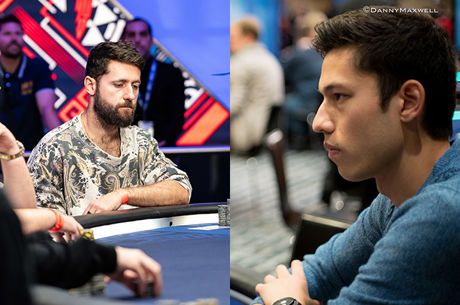When Weak Means Weak: Analyzing a Clear Bluffing Opportunity

I recently played a hand that required me to move in on the turn against an opponent who had taken the lead on multiple streets. Although my thinking in the hand was straightforward, it led to a shove that many players might miss, and the hand contains a couple of worthwhile lessons.
I was playing a tournament with 50,000-chip starting stacks. The blinds were 800/1,600 with a 200 ante, and the action started when a player with roughly 40,000 limped in from under the gun. It folded to me on the button where I had been dealt A♠J♥. I raised to 5,500, the blinds folded, and the UTG player (whom I had covered) called.
This is a small raise, especially given that we were in the ante levels, but it was enough to fold out the blinds if they didn't have much. It was also enough to start building a pot against UTG (or even to get him to fold if he was limping very weak).
The flop came K♦10♣4♣, giving me a Broadway gutshot and an overcard. The UTG player, to my surprise, led out for the 1,600 minimum into a pot of roughly 15,000. The key to this hand is interpreting this leading bet. Although we can't be completely sure what it means, these very small bets out of position often indicate that a player wants to "set his price" either with a draw or with a weak made hand.
The bad news was I had no pair, couldn't beat even a weak ten, and was vulnerable against a draw. The good news was that I was ahead of a draw and drawing live against a weak made hand. So I raised to roughly 6,700. Again, I chose a very small bet size, but it was enough to get a fold from his weakest hands, and — crucially — it left him with enough of a stack that I could get him to fold later.
He called, which put the pot at roughly 28,000. At this point he had just about the same amount behind.
The turn came the 2♥, and UTG led out for 1,600 again.
His making another weak lead made my decision very clear, because it gave even more evidence of my initial read that he had either a draw or a weak made hand.
If he had a draw, jamming would be a good play. Ace-high would probably be best in this case, and I would rather get the draw to fold in this situation than fail to charge it. If he had a weak made hand, jamming would again be a good play. Most players who think to make a weak lead do not want to call a nearly pot-sized raise all-in with just a weak pair. Finally, in the unlikely event that my read was incorrect, my hand would still have some value.
I moved in and he folded.
In truth this is a relatively simple bluff, but the hand contains a couple of useful lessons.
First, sometimes things are exactly as they seem. Weak bets don't always indicate weakness, but often they do.
Second, sometimes all roads lead to the same conclusion. Here, the question whether UTG had a strong draw, a weak draw, or a weak made hand made little practical difference, as the correct response was to jam in any of these cases.
Your time and attention are limited at the table. Don't spend it on questions the answers to which don't change your best play.
The Kindle edition of Nate Meyvis's new book, Thinking Tournament Poker, Volume 2, is now available on Amazon. Be sure also to check out Nate and Andrew Brokos on the Thinking Poker Podcast, and for more from Nate visit his blog at natemeyvis.com.
Want to stay atop all the latest in the poker world? If so, make sure to get PokerNews updates on your social media outlets. Follow us on Twitter and find us on both Facebook and Google+!










